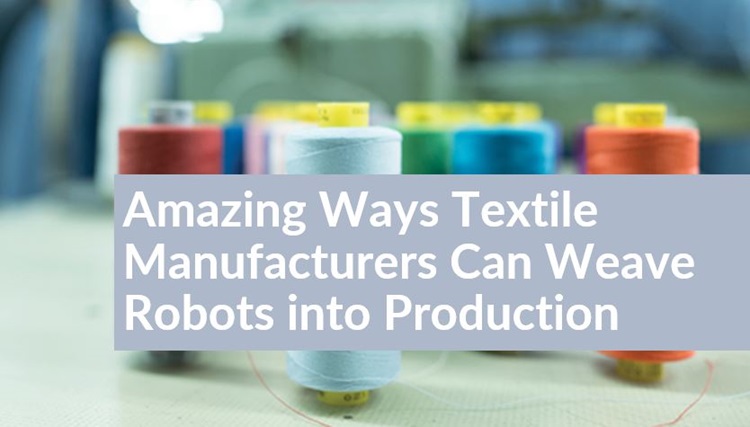Author: Emily Newton
Using robots in textile manufacturing is the next natural step in production automation, and recent technology shows promising signs of shaking up the industry in exciting ways.
While other industries have scaled quickly and incorporated innovative technologies for better and faster production, the textile industry has seen much slower growth.
Most of this slower pace is because fabrics and sewing require a certain level of human finesse – for now. Here are just a few ways the textile supply chain could see major improvements by letting robots handle fabric and production.
1. Automated Sewing
Sewing by hand is time-consuming and highly repetitive, which has been linked with musculoskeletal disorders and pain. One study found that 88% of sewing machine operators had back pain in the past year, while 82% had lower back and knee pain that prevented them from some level of normal activity in the same time frame.Machinery has lagged where large-scale sewing is concerned, and much of that is because robots have always lacked the precision and control needed to replicate hand-sewn quality on flexible materials. Modern-day robotics look to change that with advanced mapping technology, artificial intelligence (AI), and the ability to navigate more complex paths.
Robots like the Sewbo system, which shifts the sewn design to a temporary solid form to close seams without human intervention, can save employees significant physical strain while increasing production volume in less time, ultimately boosting the manufacturer’s bottom line.
Consider the impact Sewbo has already demonstrated. In one eight-hour work period, it produced more t-shirts than a 10-person assembly line could, requiring only minimal human oversight.
2. Layer Picking
Manually picking orders for processing or transit eats up more than half of a warehouse’s operating costs, mostly due to labor expenses. The reality of those costs might not be so challenging if it took special finesse or learned skill, but manual picking is notoriously tedious, especially in high-volume production.The textile industry has always been cautious about letting robots handle fabrics. Machinery has always lacked the nuance to understand the different physical care required between fabric types, and even minor mishandling could be a costly mistake.
Robotextile robotics is a game changer for textile production. The system uses a specially designed textile gripper to handle and pick each layer of fabric with precision and smooth movements.
Implementing robotics systems like this can help many manufacturers meet growing high-volume production needs and maximize their output more efficiently.
3. Quality Assurance
Consistent quality is critical in textile production, especially for large volumes. Manual quality inspections take significant time, and it’s far from precise – the human eye can only detect so much variation in color pigmentation, and no individual can test a fabric against all possible stressors.Using robots in textile production just makes more sense. AI algorithms can promote more uniformity by overseeing all parts of the manufacturing process, including specific pigment measurements, water pressure and flow levels, and fabric temperature. Robotics-powered systems can analyze textiles down to the fiber and note any color or quality inconsistencies.
The result is far more accuracy and far less product waste, ultimately saving manufacturers money and freeing employees to handle more skilled tasks.
4. Meet Increasing Demands
Global textile demand is increasing, with the market predicted to grow from $654.57 billion in 2021 to just over $861 billion over the next five years. At the same time, analysis shows that the manufacturing skills gap in the U.S. could leave more than 2 million jobs unfilled by 2030, equating to about $1 trillion in associated losses.Robots in textiles can mean meeting that demand and avoiding disruption or lost profits while potentially exceeding that demand in new ways.
Take New York-based Pvilion, a manufacturer of rapidly deployable robotic structures, for example. They were recently awarded a $1.5 million Small Business Innovation Research (SBIR) contract from the U.S. Air Force to produce higher volumes of the Hands-Off Expeditionary Tent (HEXT).
Pvilion partnered with Rensselaer Polytechnic Institute – Rensselaer Institute is funded by the U.S. Department of Defense to create self-erecting, solar-powered structures that adapt to missions and environments – to find new ways of using computer automation and robotics to improve textile manufacturing.
The result was new technology that let robots produce more consistent shelters, faster, which ended up playing a significant role during the COVID-19 pandemic. Pvilion and Rensselaer’s rapidly deployable structures created safe, adaptable shelters for testing and critical care.
Robots Bring Increased Safety, Efficiency, and Possibility to Textile Production
Though large-scale robotics deployment across the entire textile industry will take time, manufacturers should take steps now to prepare their facilities and processes for faster, more efficient operations. Aided by robots, textiles could finally move into modern-day manufacturing, bringing reduced waste, increased profits, and new possibilities with it.
About the Author:
Emily Newton is the Editor-in-Chief of Revolutionized, an online magazine that explores innovations in science and technology.
She loves seeing the impact technology can have on every industry.

